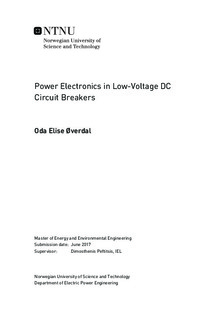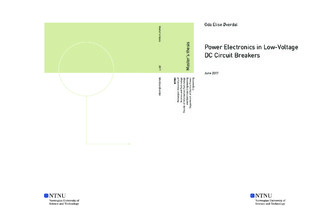| dc.description.abstract | Low-voltage direct current (LVDC) microgrid has recently been recognized as a feasible solution for next generation electrical power distribution network, due to several benefits that it offers an increasing amount of facilities. However, LVDC microgrids suffers from crucial concerns, which needs to be properly addressed before being conceived as a commercially and economically available solution for future power distribution. LVDC protection technology lacks experience, standards and guidelines, resulting in typical expensive and overdimensioned electrical components comprising LVDC systems. It is necessary to develop an economical DC protection solution, which is capable of conducting with low losses and rapid short-circuit currents interruption, without being destroyed in the process.
A promising circuit breaker (CB) based purely on power electronics, comprising 2 antiparallel connected commercially unavailable reverse blocking integrated gate commutated thyristors (RB-IGCTs) has been developed by ABB. Replacing the unavailable RB-IGCT devices in the original CB design with insulated gate bipolar transistors (IGBTs) or asymmetric integrated gate commutated thyristors (A-IGCTs), is evaluated. Based on proper parameterization, two CB configurations are presented, comprising either 12 parallel connected 3.3 kV rated IGBTs from Infineon, or 8 parallel connected 4.5 kV rated A-IGCTs from ABB. These configurations are compared against each other, using simulation models assembled in Matlab® Simulink. The higher voltage ratings of the A-IGCT allowed the CB to utilize larger metal oxide varistors (MOVs), which reduces the energy dissipation period with approximately 1 ms. The A-IGCT based CB is indicated to be more expensive, due the CB configuration being 60 % heavier than that of the IGBT based CB. On the other hand, the A-IGCT based CB is able of conduct nominal current with 23 % of the losses to that of the IGBT based CB. Since excessive conduction losses are one of the major disadvantages of solid-state CB, the 4.5 kV A-IGCT is concluded to be the most promising semiconductor device for the CB design.
The preferred CB is later utilized to protect three simplified isolated LVDC systems modelled in Simulink against short-circuit faults. Its breaking performance indicated that the A-IGCT based CB might be overdimensioned for the considered LVDC system, but is however conceived as a feasible solution. The promising CB configuration comprising 4.5 kV rated A-IGCTs was able of interrupting faults of 17.5 kA at 3000 V within approximately 2 ms of fault injection. | |

